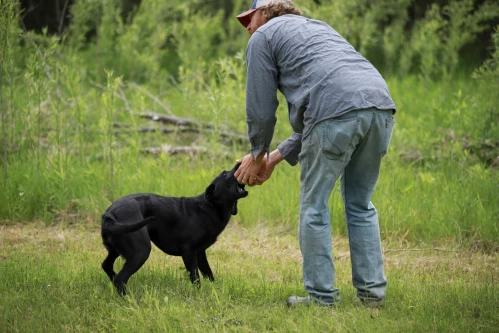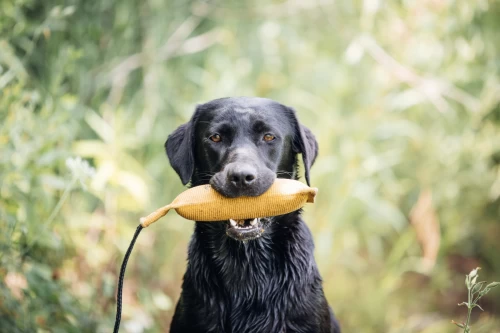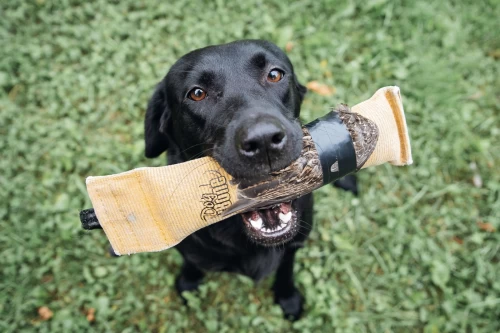Why Good Isn't Good Enough Training Your Hunting Dog
As I write this article, I have a puppy in training named Bella, just short of 9 months, old laying quietly by my feet curled up and sleeping next to the fire. She is arguably one of the sweetest, most talented pups I've trained over the last 15 years. Her sire, who lives in England, is a Field Trial Champion, an International Field Trial Champion, qualified for the IGL championship 4 times and won it once. Her Mom's pedigree is equally impressive and filled up with red ink on both the top and bottom. This pup has excelled at just about everything I have asked of her in gundog training to date, with the exception of a few small hiccups along the way, most of which were due to my shortfalls. Comfortable with gun fire, feathers, cold game and fresh killed game, she's even caught and delivered nicely to hand a number of pen-raised pheasants whose damp feathers would not allow them to rise out of the early morning dew-soaked grass earlier this summer. Simply put, I've now got myself a young dog that is well on her way to becoming a fine shooting companion.
 With seasons winding down and snow beginning to pile up, many hunting dog owners are scrambling to figure out what they can do before pulling out the tip-ups or jigging poles and only being able to dream about the next years "opening weekend". For some it might mean strapping on snowshoes and pushing deep into the cattail marshes in the hopes of locating tracks that will then lead them to the densely grouped up pockets of survivors. Hunting a long- in-the tail rooster, late in the season that has outwitted hunters and dogs for the last several months is something typically reserved for what I consider to be the "more ambitious types". Others find themselves "using up" their birds or cashing in on discounted, end of season offers at local shooting preserves in the less than dense covers, littered with empty shotgun hulls. Either of these options are just fine for those with the dogs that could use some more experience and opportunities on birds. However, they are both scenarios that would be of little or no value for Bella and me. Quite honestly, they offer much more risk than reward in our training and would almost certainly set us back significantly in our wider view goals.
With seasons winding down and snow beginning to pile up, many hunting dog owners are scrambling to figure out what they can do before pulling out the tip-ups or jigging poles and only being able to dream about the next years "opening weekend". For some it might mean strapping on snowshoes and pushing deep into the cattail marshes in the hopes of locating tracks that will then lead them to the densely grouped up pockets of survivors. Hunting a long- in-the tail rooster, late in the season that has outwitted hunters and dogs for the last several months is something typically reserved for what I consider to be the "more ambitious types". Others find themselves "using up" their birds or cashing in on discounted, end of season offers at local shooting preserves in the less than dense covers, littered with empty shotgun hulls. Either of these options are just fine for those with the dogs that could use some more experience and opportunities on birds. However, they are both scenarios that would be of little or no value for Bella and me. Quite honestly, they offer much more risk than reward in our training and would almost certainly set us back significantly in our wider view goals.
 I know that one of the most overlooked aspects of truly enjoying your dog, is the ability to have them behave in a well mannered, disciplined, under control, or simply put...nice to be around way. I think that a lot of the time we find ourselves in the market for a "hunting dog" and when I say hunting dog, I mean they could be doing one or more of many "hunting" things. The "hunting" part always seems to rise to the top and remain in focus while most, if not all of the necessary elements needed in order for us to achieve those goals remain a secondary, blurred background thought.
I know that one of the most overlooked aspects of truly enjoying your dog, is the ability to have them behave in a well mannered, disciplined, under control, or simply put...nice to be around way. I think that a lot of the time we find ourselves in the market for a "hunting dog" and when I say hunting dog, I mean they could be doing one or more of many "hunting" things. The "hunting" part always seems to rise to the top and remain in focus while most, if not all of the necessary elements needed in order for us to achieve those goals remain a secondary, blurred background thought.
I realize we are a society that likes to "keep score" using numbers to quantifying things. I don't like to, and rarely use numbers as a means of measurement when it pertains to dog training. The reason is because those numbers are primarily and most often equated to time. If you know anything about me, or my training style, I put very little value on the use of time as a means of measurement when it pertains to raising a dog. However, for this one time I think using numbers to describe how close to being complete Bella is, may be helpful. Here it goes...
 Over the last 6 months of training, Bella has proven to now be proficient on lead about 99% of the time. Off lead, she is about 60%. When it comes to retrieving, I'd say she's about 85% "there". Her recall is strong but by no means perfect, I'd say she's about 75%. Her game finding and nose work is very natural, but under exposed to this point and I'd give it about a 50% just because of the lack of opportunity she has seen. Steadiness is another skillset that we have been cautiously focused on because I find it very important to balance the dogs natural desire to retrieve with the unnatural tendencies to be patient and steady. The caution lies in carefully determining when to require it and how to enforce any breaking by the pup. It can be very counterproductive to correct or apply pressure to something that you ultimately want the dogs to desire and love. It also can be very inefficient to train in or allow undesirable habits to form early on that would need to be reversed later on down the road. For that reason, when, where and how much steadiness to ask of them will always be a discussion of great debate. At this point, having to put some kind of number to it, her steadiness is about 40% of where it needs to be in the end. Taking the percentages these, what I consider to be very important six skill sets for a young pup and averaging them out, she comes in at a 68.16%. And honestly, that sounds about right to me. She's only 9 months old and I'd says she's around 70% +/- where I need her to be in the next year or so. To put that into context, by most standards a 70% would equate to a C- in letter grade form. Although I never graduated valedictorian or summa cum laude by any stretch of the imagination, a C- grade earned in respect to how my hunting dog performs would just not be acceptable.
Over the last 6 months of training, Bella has proven to now be proficient on lead about 99% of the time. Off lead, she is about 60%. When it comes to retrieving, I'd say she's about 85% "there". Her recall is strong but by no means perfect, I'd say she's about 75%. Her game finding and nose work is very natural, but under exposed to this point and I'd give it about a 50% just because of the lack of opportunity she has seen. Steadiness is another skillset that we have been cautiously focused on because I find it very important to balance the dogs natural desire to retrieve with the unnatural tendencies to be patient and steady. The caution lies in carefully determining when to require it and how to enforce any breaking by the pup. It can be very counterproductive to correct or apply pressure to something that you ultimately want the dogs to desire and love. It also can be very inefficient to train in or allow undesirable habits to form early on that would need to be reversed later on down the road. For that reason, when, where and how much steadiness to ask of them will always be a discussion of great debate. At this point, having to put some kind of number to it, her steadiness is about 40% of where it needs to be in the end. Taking the percentages these, what I consider to be very important six skill sets for a young pup and averaging them out, she comes in at a 68.16%. And honestly, that sounds about right to me. She's only 9 months old and I'd says she's around 70% +/- where I need her to be in the next year or so. To put that into context, by most standards a 70% would equate to a C- in letter grade form. Although I never graduated valedictorian or summa cum laude by any stretch of the imagination, a C- grade earned in respect to how my hunting dog performs would just not be acceptable.
The idea of breaking down Bella's progress this way is to demonstrate a few points that I really believe strongly in when it comes to mapping out your dog's gundog training schedule both at the micro and macro level. One of those points is that if you settle for "good" being "good enough", you will likely not be satisfied the great majority of the time. A dog like Bella right now, that totals a cumulative ballpark 70% score will prove to perform at a level of 70% (at her best) maybe up to 70% of the time (again, at best). That kind of dog work will prove to be very frustrating because that less than 70% performance almost always, and without fail shows up at the exactly the "wrong time".
 The second point is connected to the idea and importance of sequencing and the ongoing search for balance in training. To simplify it, look at your overall hunting and lifestyle goals with your dog as a chain. The bigger the goals you have, the longer the chain will need to be. In order for any chain to be effective, it takes links, and those links must all be connected. If you and your dog are missing a links, the chain is no longer effective. And of course, we all know the old proverb "a chain is only as strong as its weakest link". Because your training links are integrally connected, if you are missing or lacking in any particular skill sets along the way, you won't be able to move on to the next. It's about the only thing I can tell you with 100% certainty. Of all these numbers, settling for partial training will get you partial results at best...EVERY TIME.
The second point is connected to the idea and importance of sequencing and the ongoing search for balance in training. To simplify it, look at your overall hunting and lifestyle goals with your dog as a chain. The bigger the goals you have, the longer the chain will need to be. In order for any chain to be effective, it takes links, and those links must all be connected. If you and your dog are missing a links, the chain is no longer effective. And of course, we all know the old proverb "a chain is only as strong as its weakest link". Because your training links are integrally connected, if you are missing or lacking in any particular skill sets along the way, you won't be able to move on to the next. It's about the only thing I can tell you with 100% certainty. Of all these numbers, settling for partial training will get you partial results at best...EVERY TIME.
In years past and early on in my training career, I was the guy that took his dog out hunting too early. I justified it thinking that the more experience I could give them, the better of we would be. I also didn't understand the answer to the self-asked question "what do I have to lose?" Years, and many mistakes later I realized there was plenty to lose and maybe more importantly, very little to gain. When it comes to Bella specifically, she has the makings from a genetically and the beginnings from a foundation standpoint. But in the scenario of taking her into the field at this point on a hunt, her natural hunting and game finding abilities exceed her ability to focus and work through distractions. These scenarios involve much more temptation than the level of control I have of her. I know that if she were to get downwind of one of those wiry old running roosters, she's not going to be called off and surely not willing to wait for me to get into gun range before resuming to flush. Instead, her denial of my attempted recalls would result in a fun game of run, chase and flush for her, followed at best by a disappointed and frustrated recall from me. And that's if the handler is able to keep their cool. By this point, most handlers are so upset at their young dogs, many hesitate to return. Think about it, would you want to come back to someone who is screaming at you and clearly upset? It's points like this in the field that quickly erase, erode and fade away so much of the hard work and habit forming we work so hard to gain in controlled training up to this point.

What I have found is that being patient and taking the time to truly master and perfect everything to a level of 100% (or as close to 100% as possible) consistently and completely and not settling for "just good enough" allows us to always form the next "link" for the chain. When we are willing to do that, which means we might miss a few hunts or even a season, we ensure that we are prepared and ready to handle those situations when temptation and distractions escalate. Giving up a marginal season with a young dog to ensure the balance of your hunting years are solid is well worth it in the long run.
If you are interested in watching Bella's complete video training series, be sure to check out the "Bella...Be Good" series playlist in our DogBone Training Library. Best of luck in your training!
For Hunting Dog Training Products: DB Store
For more articles: Jer's Journal
For Podcasts: DB Podcast

 About
About Reviews
Reviews Free Videos
Free Videos Journal
Journal Podcast
Podcast

%COMMENTS%